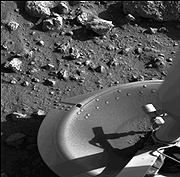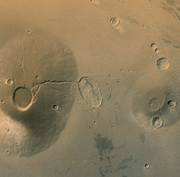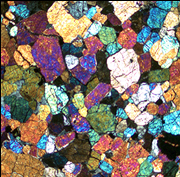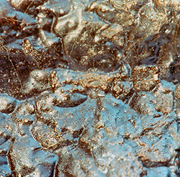Pieces of the Red Planet
Most achondrites come from the crust of differentiated asteroids. However, three types of achondrites stand out from the others. They are called SNC meteorites, for the initials of three very special meteorites that fell in Shergotty, India, in Nakhla, Egypt, and in Chassigny, France. These meteorites are from Mars.

Enlargement
First photo of the surface of Mars taken by the Viking 1 probe just after it landed on the red planet on July 20, 1976. Until samples can be brought back and manned missions sent, SNC meteorites are the only clues we have about the history of this planet. |
How can scientists be sure that these meteorites come from Mars? An unusual age of 1.3 billion years has been calculated for SNC achondrites, while meteorites from the asteroid belt are all 4.5 billion years old. The late-stage crystallization of the SNCs proves that they come from a body much bigger than an asteroid, and which cooled slowly. As it happens, volcanic activity continued on Mars for a long time after its formation. SNC meteorites contain other proof of their origin: the gases trapped in these meteorites very closely resemble the gases recorded in the Martian atmosphere by the Viking probe.
The SNCs are shocked achondrites-they were altered by the collision that ejected them from their planet. One serious candidate for the location they may come from is the oval-shaped impact crater at the base of the volcano Ceraunius Tholus. These meteorites roamed through the emptiness of space before coming to visit the neighbouring planet!
 |
| Enlargement |
| The crater at the base of Ceraunius Tholus measures 14 by 31 kilometres. The oblique impact must have hurled debris into space at a high speed. |
 |
Enlargement
|
| Thin sections of the three types of Martian achondrites (top to bottom: shergottite, nakhlite, and chassignite) viewed in polarized light. They solidified from volcanic magma at or under the surface of Mars. |
 |
| Enlargement |
| Close-up of the fusion crust of the shergottite Los Angeles 001. This glossy fusion crust is typical of young Martian achondrites. |
|